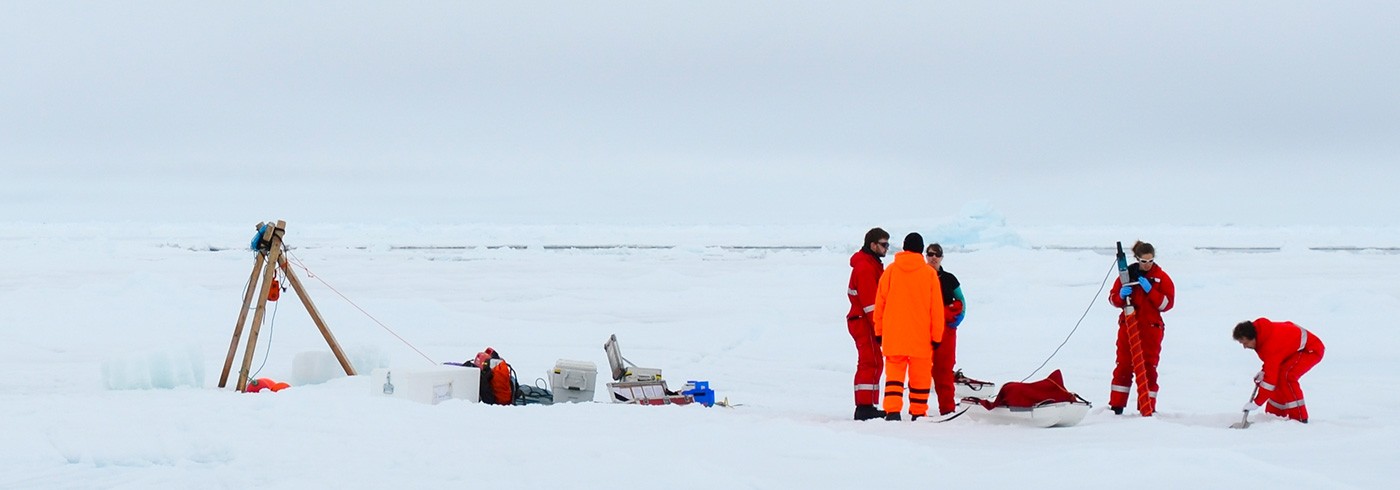How are the living conditions of the Arctic Cod affected by decreasing sea ice?
24 May 2017 - 21 July 2017
An ice-tethered 200 m long mooring line, was deployed for measurements of water velocities, temperature and salinity during the PS106.1 twelve-day drift. Photo: Stephan Schön

The shipboard CTD-Rosette deployed from the aft of research vessel Polarstern. Photo: Marcel König

The Swedish team of PS106, responsible for the physical oceanography measurement program. From left: Sara Sahlin, Anna Nikolopoulos, Torsten Linders, Elin Andrée and Céline Heuzé.
A unique habitat has been created under the sea ice in the Arctic. The Arctic Cod (Boreogadus saida) is one of the numerous species that begin their lives there. There are plenty of holes and cracks under the ice where young fish can hide from larger creatures. There is also plenty of food there which makes the ice a perfect habitat for juvenile fish. The Arctic Cod is a staple food for several Arctic species such as the ringed seal and various types of sea birds, and it thereby plays an important role in the Arctic ecosystem.
The purpose of the PS106 SIPCA expedition was to study the living conditions of the Arctic Cod in the Arctic Ocean during late spring and early summer. The main focus of our research was therefore the properties and movements of the water in the area.

Overview map of the two cruise tracks of PS106. The hydrographic measurements during PS106.1 were made over the eastern rim of the Yermak Plateau and the shelf slope north of Spitsbergen, while the measurements of PS106.2 were made in the Barents Sea, over the shelf slope north of Nordaustlandet and Kvitøya as well as in the deeper parts of the Nansen basin. Circles show shipboard CTD stations (white symbols indicate dedicated-ice stations). Squares show the positions for expendable XCTDs.
The German research icebreaker Polarstern was used for the expedition, which was carried through in two legs: in the southwestern part of the Nansen Basin and in the western Barents Sea. Sea conditions in this part of the Arctic are characterised by the relatively warm Atlantic water that flows into the Arctic. The area southeast of Svalbard is also a typical shelf sea. Shelf seas are considerably shallower than the deep central basins and are believed to play an important role for circulation in the Arctic Ocean.
The measurements were done primarily with the help of a CTD which measures the water salt content, temperature and depth, as well as trace elements and chlorophyll. In addition, the water particle composition and currents were measured by a mooring from the ice. The bottom temperature of the water will be continuously measured for a two-year period, using eight sensors that were placed on the seabed during the expedition.
The results will contribute to our knowledge about
- the inflow of water from the Atlantic
- the variation of the deep water properties
- the interactions between the water and sea ice.
This is essential knowledge for understanding what processes affect the Arctic Cod and other important parts of the Arctic ecosystem.

Deployment of one of the LoTUS bottom landers from the ship’s side. LoTUS, Long Term Underwater Sensing, are manufactured by the Royal Institute of Technology (KTH) and the Tpop:s are manufactured by the University of Rhode Island (USA). Photo: Sara Sahlin

The large black instrument is an LISST which measures particle composition or ice-tethered ADCPs for water velocities. It is photographed by the ROV (remotely operated vehicle) just below the sea ice. The LISST was accompanied by a CTD (white), and a turbidity sensor. Photo: AWI SeaIce-ROV team

